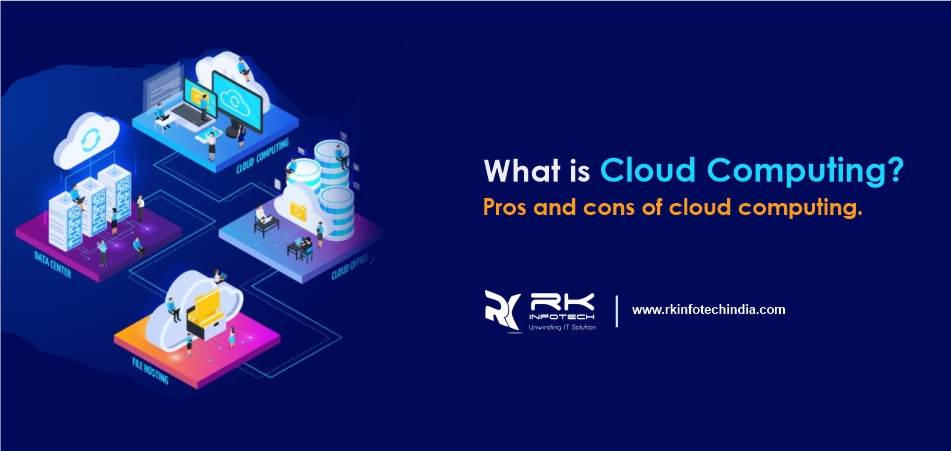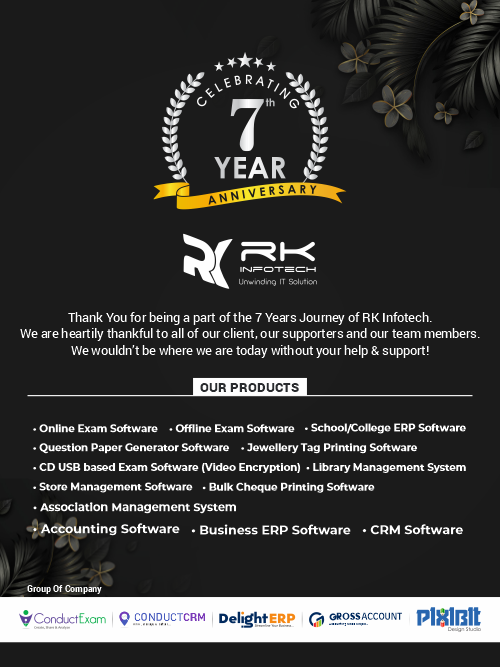What is Cloud Computing? Pros and cons of cloud computing
Introduction
Hug number of small-scale and large-scale business sectors from all over the world are using cloud computing today. Because it becomes difficult with the challenges they face for in-house infrastructure solutions.
As scalable, increased automation, dependable and cost-effective, cloud storage is fast surpassing physical in-house systems as the next frontier of business computing and software and application delivery.
Every business needs a safe and secure storage area where data and applications can be accessed and operating expenses are kept to a minimum.

What is cloud computing?
Before understanding cloud computing, let’s understand what cloud is.
The cloud means servers that are acquired over the internet, and the software and databases that run on those servers.
Cloud Computing is the delivery of computing services including storage, database, servers, analytics, intelligence, software, and networking over the internet i.e. on a cloud to offer flexible resources, faster innovation, and economies of scale.
In simple words, it demands running computer/network applications that are present at some other place on other people’s servers with the use of a simple user interface or application format.
It is believed that most people are using Cloud computing for their business.
As a virtual hosting service, cloud computing is much more conceptual. Rather than being accessible via physical hardware, all servers, software, and networks are hosted remotely in the cloud. It is a virtual environment hosted in real-time by multiple servers concurrently.
Models of Cloud Computing
It includes Deployment Model and Service Model. Let’s understand them:
Deployment Model:-
How an organization handles its operations and secures business assets and needs can be reflected in how it deploys its cloud service.
Public Clouds:-
Public clouds are owned and operated by a third-party Laas cloud provider. Which delivers computing resources like servers and storage over the internet. With the public cloud, all hardware, software, and other supporting infrastructure is owned and managed by a cloud provider. Thus you can access and manage your account by using a web browser.
Private Clouds:-
A private cloud refers to cloud computing resources that are exclusively used by a single business.
In other words, in a private cloud, cloud computing services, infrastructure, and networking are operated solely by an organization independent of other enterprises or public platforms.
It can be maintained in one of two ways: A company’s data center is physically located in-house, or a third-party vendor is paid to host everything in a private instance.
Hybrid Cloud:-
Hybrid cloud deployment is a combination of public and private clouds, bound together by technology that allows data and applications to be shared between them.
The private side can be used for sensitive data processes such as finance and data recovery, whereas the public side can be used to run high-volume applications.
Service Model:-
The dynamic effects of cloud adoption are already paying out and are present in three wide-ranging and common models of cloud computing services: Software-as-a-services (Saas), Infrastructure-as-a-services (Iaas), and platform-as-a-services (Paas).
Another characteristic is that the computing, networking, storage, and integration capabilities of each Saas, Laas, and Paas offering are effectively owned by the vendor and delivered as a service on an on-demand, subscription basis to the customer.
These three categories are designed to be put together on top of one another, which means they can work independently of each other or in a combination.
1. Software-as-a-service (Saas):-
Software-as-a-service is a method of delivering software applications over the internet, on-demand, and typically subscription-based.
It is referred to as “on-demand software”, cloud computing Saas is the most commonly implemented cloud computing service for business customers.
With a wide variety of application and service types, Saas is replacing traditional enterprise systems including ERP, accounting, human resources management, content management systems, supply chain and inventory management, and customer relationship management (CRM) programs, among others.
Saas doesn’t require purchasing an expensive licensed program, users can access numerous cloud applications on an as-needed basis.
Advantages of Saas:
- Get access to sophisticated applications.
- Access app data from anywhere.
- Play only for what you use.
- Mobilize your workforce easily.
- Use free client software.
2. Infrastructure-as-a-service (Iaas):-
With Iaas, you can rent IT infrastructure servers and virtual machines (Vms), storage, networks, and operating systems- from a provider on a pay-as-you-go basis. By building cost-saving and scalable IT complex and expensive hardware is outsourced to a third-party cloud vendor.
All of these IT components are automated for customers who can self-provision the storage or processing power of the Iaas platforms. Vendors are also responsible for ongoing maintenance, including system upkeep, backing up data, and business steadiness.
3. Platform-as-a-service (Paas):-
Platform-as-a-service refers to cloud computing services that supply an on-demand environment for testing, developing, and managing software applications. Paas is designed to make it easier for a developer to create web or mobile apps, without worrying about setting up the underlying infrastructure of servers, storage, network, and database needed for development.
Examples of leading Cloud Computing Companies are Amazon Web services, Microsoft Azure, Google Cloud Platform, Oracle, etc.
Pros and Cons of Cloud Computing:-
The advantages of cloud computing are varied and powerful as you might realize, so let’s take a deep dive into what this technology can do for you.
The following are the Pros of cloud computing:-
1) Enhance Automation: –
Cloud computing services lead toward automating these regular backups so your team can get back to doing the work which helps in improving your business.
2) Impact on the Workforce: –
Maintaining an in-house IT team that is ample to manage local servers can quickly lead to a ballooning budget. Your company’s in-house team comes with the added cost of benefits, which cloud service can help decrease.
The service provider takes care of maintenance and backups, and you refocus your in-house team or avoid the cost of expanding it in the future.
3) Reduce Infrastructure costs: –
In-house data storage costs companies a huge amount of money. Even if you invest in the best equipment, something can break down due to human error.
With cloud computing, the headache associated with maintaining in-house systems will go with the help of your service provider. Because the cost of infrastructure is included in your plan and divided among all the service provider’s clients, you save money.
4) Defend against disaster: –
Data loss can become a disaster for the company. Here cloud-based storage is more secure than operating an on-site data center. The main advantage of storing the data in the cloud is there won’t be a single failure. Your data gets backed up on several servers, so if one gets failed, your company’s information remains safe and secured.
5) Stay scalable: –
Cloud computing helps you to pay only for the amount of storage your business requires.
6) Save on space: –
Servers and all other associated equipment take up significant square footage and expanding an in-house system often requires careful planning to secure the right amount of space. Here cloud computing can free up your office for more workspace or amenities while removing the need to plan for future equipment expansion.
7) Enhance Compliance: –
Hundreds of regulations that govern different types of data are complex to understand, time-consuming to apply, and laborious to maintain. A good provider operates in full conformation with all applicable regulations, so you don’t have to worry about incurring violations.
8) Consolidate your Data: –
With the help of cloud storage, data is distributed amongst bi-costal data centers. Syncing technology makes it practicable to link up and update data quickly, but storing data in the cloud makes syncing unnecessary. When all your data is stored in the cloud, you know exactly where your information is at any given time.
9) Maximize uptime: –
The financial impact of unplanned downtime cannot be understated. Switching to cloud computing, decrease the length of downtime.
10) Expand collaboration: –
Cloud computing helps multiple employees to view and make changes to files and documents in real time, providing a much more systematic way for workers to collaborate on projects.
Acquiring documents in the cloud helps ensure everyone is working from the correct version of a document and that obsolete versions don’t get passed between local sources.
The following are the Cons of Cloud Computing:-
Yet it is hard to ignore the advantages of cloud computing but it does have a few disadvantages.
1) Restricted Control: –
Because the infrastructure of the cloud is owned and managed by a service provider, businesses may panic about not having full control over the service.
2) Vendor Lock-in: –
Here the limitation of cloud computing can come in the form of vendor mismatches. Organizations might run into difficulties when migrating services to a different vendor with a different platform. If this process isn’t handled rightly, data can be uncovered to unnecessary vulnerabilities.
A good cloud services provider has the skill to migrate your data between vendors safely.
3) Internet Use: –
If you’re running backups during business hours when people are heavily using the internet, a large backup to the cloud has likely to increase congestion and reduce your internet performance. However, a good provider will work with you to keep away from this issue through scheduling or automation.
4) Internet Reliance: –
One minor limitation of cloud computing is the fact that it’s completely reliant on the internet. If your internet connection collapse, you won’t have access to data stored in the cloud for the duration of the interruption. An internet outrage won’t destroy or compromise your data stored in the cloud.
5) Slower Backups and Restores: –
Here moving data to the cloud involved some significant communication latency, and backups can end up taking longer than they would with in-house systems. The longest backups can run in the background without disturbing networks, and the subsequent smaller backups take less time.
6) Comprehending the costs: –
Though Cloud can help decrease costs in some areas, it is essential to make sure that when you move to the cloud, it truly makes sense. It is essential to put a proper plan in place and look at all systems within the organization.
7) Moving from cloud to on-premises: –
Moving from cloud to on-premises to cloud data centers is usually an easy process for your company. But here moving from one cloud provider to another or back to on-premises is not easy. This process is much more expensive.
Conclusion
Here pros and cons of cloud computing lean much more heavily toward benefits than limitations. Cloud is a managed service that can help companies of any size save time and improve their business. But not every provider can offer the same quality level of benefit. RKInfotech Provides IT Solutions and services with passion and precision unmatched in the industry.








